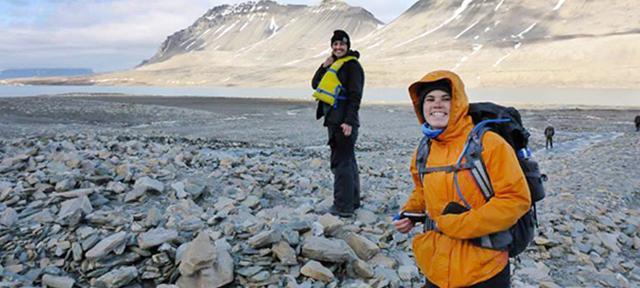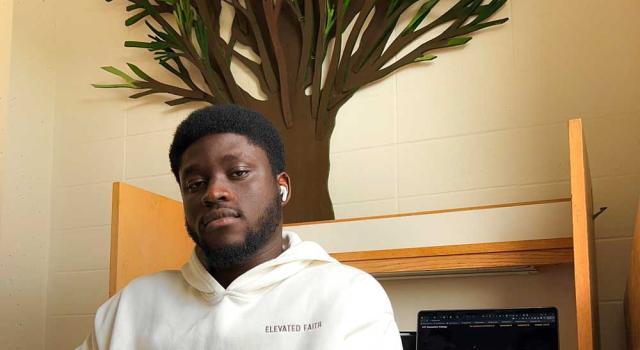For Amber Bonarrigo, Ice Meets Math in Svalbard

Division III student Amber Bonarrigo is developing a mathematical model that simulates ice duration in Lake Linné.
Hometown: Homewood, Illinois
Division III: Modeling Arctic Lake Linné: An Exploration of Lake Ice and its Implications for Climate Change
Faculty Advisers: Steven Roof, Professor of Earth and Environmental Science; Sarah Hews, Assistant Professor of Mathematics
Academic Intersections: Geology, Mathematics, Design, Climate Change
Amber: Last summer I received a Four College Biomath Consortium fellowship that allowed me to spend three weeks in Svalbard, in the Arctic, studying the temperature of Lake Linné's water column. Professor of Earth and Environmental Science Steven Roof coordinates a climate change research program for undergraduates there, and he has a ten-year record of when the ice starts and when it melts on the lake. I wanted to use that data to develop a mathematical model that simulates ice duration, and for that I worked with Assistant Professor of Mathematics Sarah Hews.
The Intergovernmental Panel on Climate Change has climate projection data that simulate the climate of the future. I can use those projections, in conjunction with the ten-year record Steve has compiled, to determine what the ice duration will be 50 or 100 years from now, which is my ultimate goal.
I've worked with Steve since day one at Hampshire. He was the professor of my Earth Resources tutorial my first semester. I'd intended to do environmental engineering and design, but when I took that class I fell in love with geology. It's an all-encompassing subject in relation to the Earth and how it works. I'm a tinkerer at heart, so in order to understand climate change I need to understand how the Earth works and how it has worked over its history. That's the core of geology.
The semester after that tutorial Steve asked me to be his assistant. The next year, he asked me to compile an observation record of the temperature data from the project. I did that in the second semester of my second year, and was able to present that at the Geological Society of America's annual conference in Denver. I decided to keep working with it for my Division III project.
The focus of my Div III is climate change, using the simulation model as a tool to continue to persuade people that climate change is a problem. If we continue to go down the “business-as-usual” path, these lakes that are usually frozen two-thirds of the year will be melted year round. The condition of lake ice is linked to glaciers, and data show that surrounding glaciers have retreated two kilometers in 80 years. I hope to use the model and data as a tool to get people on board to make changes in their daily lives in response to climate change.
For the mathematical modeling, I collaborated with third year student Lewis Blake 12F. He's another of Sarah Hews’s students—we met at a Biomath boot camp at Smith College that Sarah taught. He's actually continuing the project, honing the sensitivity of the model so that we can do more with it. After Hampshire, I’m probably going to be analyzing hydrogeology of the Atacama Desert in Chile. In the next year or so, I hope to get into environmental consulting related to groundwater remediation and cleanup. And after that, I plan to go to graduate school for climate change and geology research.
Steve Roof: We study the Arctic lake ice to see what happens today in order to understand what happened in the past, and hypothesize what may happen in the future. I kept trying to temper Amber's expectations of what she could accomplish during her Division III, but she pulled it off. The sensitivity of the model still needs testing, but when she gets it tuned up, it will be a very valuable model that can be published. Amber stood out early on as someone who had a good skill set and curiosity, and also the ambition to learn and discipline needed to advance that curiosity. When Amber got the Biomath fellowship, it was her ticket and mine to go to Svalbard that year. I've been taking students into the field and funding them for ten years, so it was a pleasure to be funded. It was the first time one of my students applied for and received that type of fellowship, and when we got there she did all the things we expected.
Sarah Hews: I met Amber in her first year, in my Calculus in Context class. It's a pure joy for her to work on problems and solve puzzles. In my mind, she's the quintessential Hampshire student. She's able to take a small piece of a field, read articles about it, and learn on her own. Then she's able to build and create with it. Her ability to move back and forth between disciplines and pick them up easily is incredible. And her work with Lewis Blake is a model that the Biomath Consortium is trying to push because it’s incredibly valuable. Now Lewis has a sense of what it takes to do Division III work, and it was an excellent opportunity for Amber to learn how to delegate and collaborate with someone in another field.



